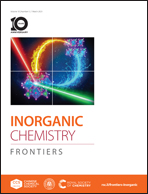Sacrificial ligand route to hybrid polythiophene–silver nanoparticles for sinter-free conductive inks†
Abstract
We report the synthesis of AgNP@PEDOT:PSS hybrid conductive particles with silver cores and polythiophene shells that can be used to formulate sinter-free inks for printing electronics. First, Ag nanocrystals capped with the weakly bound ligand aminohexanoic acid (ε-Ahx) are prepared. The ligand shell is exchanged by reacting the dispersion with the polymer ionomer mixture poly(3,4-ethylene dioxythiophene):polystyrene sulfonate (PEDOT:PSS). The particles are characterized by electron microscopy, dynamic light scattering, Z potential, and Raman spectroscopy, confirming the replacement of the ligands on the metal particle surface. The resulting dispersion is colloidally stable as confirmed by DLS. Inks with a solid content of the hybrid particles of 300 mg mL−1 were prepared and deposited on different substrates. The new particles are components for hybrid inks that become electrically conductive without any chemical or thermal post-deposition treatment. We show that silver-based hybrid inks can be deposited on different substrates and possess an average conductivity after 24 h of drying at room temperature of 1.726 × 106 S m−1 ± 0.326 × 106 S m−1, only one order of magnitude lower than elemental silver and within the same order of magnitude as their gold ink counterpart.



 Please wait while we load your content...
Please wait while we load your content...